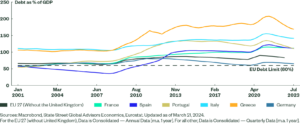Key takeaways
The global economy is slowing.
The eurozone economy showed signs of further weakening, and China reported data that revealed a bumpy path toward an economic rebound.
All eyes on the Fed.
The Federal Open Market Committee meets this week. The most important thing to watch, in my view, is the press conference following the rate announcement.
Singles Day in China.
In my view, a good gauge of the Chinese consumer is Singles Day, an extremely important shopping event in China that occurs in November.
October was quite a month, and November promises to be just as busy in terms of market news. Here’s a brief summary of the highlights — and lowlights — of the past month, and what I’ll be watching in the weeks ahead.
The highlights and lowlights of October
Lowlight: With little fanfare, the 3-month/10-year US Treasury yield curve inverted last week, arguably confirming the 2-year/10-year US Treasury yield curve inversion as a recession indicator. Keep in mind that the 3-month/10-year yield curve is generally the preferred recession indicator of Federal Reserve (Fed) officials, and is even used by the New York Fed in its recession probability models. Ironically, however, while investors fretted about the 2-year/10-year inversion, they seem to be more sanguine about this inversion, assuming it could mean a faster Fed pivot.
Highlight: October brought positive performance from US stocks.1 I think a combination of factors were at work, including expectations of a Fed pivot coming sooner rather than later, oversold conditions created by the sell-off in September, and better-than-expected earnings thus far (although there have been some very notable disappointments).
Lowlight: The European Central Bank (ECB) hiked rates 75 basis points again, with little guidance on what will happen in the future. In its most recent statement, the ECB noted it had made “substantial progress” in tightening and replaced language indicating that it will raise rates for the “next several meetings” with a more ambiguous reference to increasing interest rates “further.” This has suggested to some that the ECB will soon make a subtle pivot.2 However, whether the ECB will soon pivot is unclear. ECB President Christine Lagarde shared, “We have acknowledged more rate hikes are in the pipeline but at which pace and to which level I cannot tell you.”3 As I have said before, I worry about the ECB hiking rates significantly since much of the inflationary pressures in Europe can’t be impacted by monetary policy. It’s no surprise that the outlook for the European economy is growing dimmer.
Highlight: The Bank of Canada got less aggressive, hiking rates just 50 basis points last week. Bank of Canada Governor Tiff Macklem explained, “This tightening phase will draw to a close…We are getting closer, but we’re not there yet.”4 This occurred despite relatively strong economic data and an anticipated hike of 75 basis points by the US Federal Reserve next week. As someone who has been concerned about the breakneck speed of tightening for some central banks, I believe this is welcome news. The Bank of Canada may be in the vanguard of Western central banks making a “subtle pivot.”
Highlight: The Bank of Japan is in a very different place than its Western counterparts. In its most recent decision, it kept rates static and maintained yield curve control. It also increased its inflation forecast to 2.9%.
Lowlight: The global economy is slowing:
- Eurozone. The eurozone economy showed signs of further weakening, as October flash Purchasing Managers Indexes (PMIs) deteriorated from their September readings. Manufacturing PMI fell to 46.6 in October, from 48.4 in September.5 This was well below expectations – and marked the fourth month in contraction territory. Perhaps most concerning is that new orders contracted substantially. Services PMI also fell in October, marking the third month in contraction territory.5 In addition, input cost inflation accelerated in October.
- United States. US third-quarter gross domestic product (GDP) growth of 2.6% was better than expected, and a welcome change after two quarters of contraction. Not surprisingly, it was met with a positive stock market reaction.6 However, my colleague Paul Jackson has pointed out that stripping out the net export and inventory effect paints a different picture — one of far lower growth (though still in positive territory). He also noted that fixed investment has shrunk in the last two quarters, which is concerning given that it has often been the component that leads the economy into recession.
- China. China reported its delayed GDP and economic data, which revealed a bumpy path toward an economic rebound. The good news is that household consumption has risen significantly; the bad news is that it is still below pre-pandemic levels.
Lowlight: Last week was a difficult one for Chinese equities, which were down dramatically following the National Party Congress. There could be continued weakness in the near term, as investors worry about reports of COVID-related lockdowns and wait for more information on economic policies going forward. The good news is that China equity valuations look attractive relative to history. The most recent sell-off has pushed valuations close to historical lows. Chinese equities’ cyclically adjusted price-to-earnings ratio (CAPE) is 13.7, slightly above its historical low of 13.1 (by way of comparison, the current CAPE for the US stock market is 31.8 and that for India is 37.6).7
“Medium-light”: US earnings reports were relatively disappointing last week, with some major tech companies posting underwhelming results. But the news across the board hasn’t all been disappointing, and thus far earnings season has been relatively solid. As of October 28, 52% of S&P 500 companies have reporting earnings. Of those, 71% reported a positive earnings per share surprise and 68% reported a positive revenue surprise.8 The energy and information technology sectors have had a better earnings season so far, with the highest percentages of companies reporting earnings above estimates, 89% and 84% respectively. However, the materials and utilities sectors have had disappointing earnings seasons so far, with the lowest percentages of companies reporting earnings above estimates, 55% and 57% respectively.8
What to watch in November
The Federal Open Market Committee (FOMC). The FOMC will be meeting this week, but I’m not expecting any surprises. There is strong consensus that the fed funds rate will be increased 75 basis points. The most important thing to watch, in my view, is the press conference following the announcement. Some believe this will be when the Fed pivots. I think this could very well be the pivot, but it could be a subtle pivot like the Bank of Canada’s. I think it’s very possible that Fed Chair Jay Powell could echo Macklem’s message that it is appropriate to slow down rate hikes going forward, to give time for the tightening that has happened thus far to be reflected in the economy. In other words, tightening would continue — just at a slower pace. That would be good enough for me, but it might not be good enough for markets. (I’ll be giving my reaction to the Fed’s press conference on Nov. 3. Register now to attend this live event on LinkedIn: Fed Watch: Is a soft landing still possible?)
US midterm elections. It seems very clear to me that Democrats are likely to lose the House of Representatives, although it’s questionable what will happen in the Senate. For our purposes, though, the midterm elections are unlikely to have much impact on markets. Of course, investors tend to like checks and balances in government, so a split Congress could be a slight positive. However, it is worth noting that what has historically mattered more is the year itself; the third year of a presidential cycle has, over time, tended to be the most positive for stock market returns.9 Let’s hope history repeats itself this time around.
Inflation. Some are hoping for “immaculate disinflation,” the idea that prices fall quickly, especially in the US. However, I don’t think it will be as easy or clean as that. Some sources of inflationary pressure are easing quickly, such as global supply chain pressures, while other sources could be more stubborn, including wages. What’s more, components that are easing, such as global supply chain pressures, could reverse if we were to see significant COVID lockdowns again, as we did in the spring.
Global PMIs. We’ve been in an extraordinary environment of synchronized tightening on the part of many central banks. Given that there is a lag, while we have seen some economic damage, I believe we have yet to see much of the impact of this tightening on the economy. PMIs, especially the new orders subindex, can often be the first “canary in the coal mine.” We will want to monitor those closely. I’m comfortable with modest month-over-month declines, given that central banks are engineering a potent slowdown. However, any sharp drop would be cause for concern and a sign that central banks had “overdone” tightening.
Singles Day in China. There’s a lot of gloom and doom surrounding China and its economy. However, more important than sentiment is actual results. In my view, a good gauge of the Chinese consumer is Singles Day, an extremely important shopping event in China that occurs on November 11 (although in recent years has been extended into multiple days). Recall that in 2020, Singles Day sales provided an accurate sign that the Chinese economy had rebounded substantially from the initial COVID downturn. Sales numbers this year could give us a good sense of how the Chinese economy is rebounding from its recent downturn — and especially how strong the Chinese consumer is.
The Russia-Ukraine war. Of course, this war has had a major impact on the global economy, driving down growth and driving up inflation. So we will want to follow developments in coming weeks, especially as the weather gets colder; some believe this could give Russia a military advantage, given Russia’s history of several notable military successes in winter. One development that could be very problematic for food prices is the new Russian embargo on Ukrainian grain (basically a suspension of participation in a previously agreed-upon deal to allow Ukrainian grain to be exported from its Black Sea ports).
More earnings. We still have a ways to go with earnings season, and the coming weeks could reveal more disappointing earnings that could alter market sentiment for the worse.
With contributions from Paul Jackson and Thomas Wu.
Footnotes
- 1Source: Bloomberg, L.P., based on total returns for October for the S&P 500 Index (8.10%), the Dow Jones Industrial Average (14.07%), and the NASDAQ Composite index (3.94%).
- 2Source: European Central Bank as of Oct. 27, 2022
- 3Source: Yahoo Finance, “Euro slides after ECB’s more dovish tone on rate outlook,” Oct. 27, 2022
- 4Source: Global News, “Bank of Canada says economy will ‘stall’ amid rate hike but skirts recession call,” Oct. 26, 2022
- 5Source: S&P Global, as of Oct. 24, 2022
- 6Source: US Bureau of Economic Analysis
- 7Source: Refinitiv Datastream and Invesco. Based on daily data for US from Jan. 3,1983, for China from April 1, 2004, and for India from Dec. 31, 1999, using Datastream indices, as of Oct. 28, 2022.
- 8Source: FactSet Earnings Insight, as of Oct. 28, 2022
- 9Source: Bloomberg, Dow Jones. As of Dec. 31, 2021. Based on the Dow Jones Industrial Average from 1900-2021. Over that time period, the average return for Year 1 of a presidential cycle was 11.5%, for Year 2 it was 7.2%, for Year 3 it was 16.6%, and for Year 4 it was 12.0%.
—
Originally Posted November 1, 2022
Global markets: What to watch in November by Invesco US
Important information
NA 2553481
Past performance is not a guarantee of future results.
An investment cannot be made directly in an index.
This does not constitute a recommendation of any investment strategy or product for a particular investor. Investors should consult a financial professional before making any investment decisions.
All investing involves risk, including the risk of loss.
The Federal Open Market Committee (FOMC) is a 12-member committee of the Federal Reserve Board that meets regularly to set monetary policy, including the interest rates that are charged to banks.
A basis point is one hundredth of a percentage point.
The federal funds rate is the rate at which banks lend balances to each other overnight.
The yield curve plots interest rates, at a set point in time, of bonds having equal credit quality but differing maturity dates to project future interest rate changes and economic activity. An inverted yield curve is one in which shorter-term bonds have a higher yield than longer-term bonds of the same credit quality. In a normal yield curve, longer-term bonds have a higher yield.
Purchasing Managers’ Indexes are based on monthly surveys of companies worldwide, and gauge business conditions within the manufacturing and services sectors.
Gross domestic product is a broad indicator of a region’s economic activity, measuring the monetary value of all the finished goods and services produced in that region over a specified period of time.
CAPE, or the cyclically adjusted price-to-earnings ratio, is calculated using real earnings per share (EPS) over a 10-year period to smooth out fluctuations in corporate profits over different periods of a business cycle.
The Dow Jones Industrial Average is a price-weighted index of the 30 largest, most widely held stocks traded on the New York Stock Exchange. The NASDAQ Composite Index is the market capitalization-weighted index of approximately 3,000 common equities listed on the Nasdaq stock exchange.
Many products and services offered in technology-related industries are subject to rapid obsolescence, which may lower the value of the issuers.
In general, stock values fluctuate, sometimes widely, in response to activities specific to the company as well as general market, economic and political conditions.
The opinions referenced above are those of the author as of Oct. 31, 2022. These comments should not be construed as recommendations, but as an illustration of broader themes. Forward-looking statements are not guarantees of future results. They involve risks, uncertainties and assumptions; there can be no assurance that actual results will not differ materially from expectations.
Disclosure: Invesco US
This does not constitute a recommendation of any investment strategy or product for a particular investor. Investors should consult a financial advisor/financial consultant before making any investment decisions. Invesco does not provide tax advice. The tax information contained herein is general and is not exhaustive by nature. Federal and state tax laws are complex and constantly changing. Investors should always consult their own legal or tax professional for information concerning their individual situation. The opinions expressed are those of the authors, are based on current market conditions and are subject to change without notice. These opinions may differ from those of other Invesco investment professionals.
NOT FDIC INSURED
MAY LOSE VALUE
NO BANK GUARANTEE
All data provided by Invesco unless otherwise noted.
Invesco Distributors, Inc. is the US distributor for Invesco Ltd.’s Retail Products and Collective Trust Funds. Institutional Separate Accounts and Separately Managed Accounts are offered by affiliated investment advisers, which provide investment advisory services and do not sell securities. These firms, like Invesco Distributors, Inc., are indirect, wholly owned subsidiaries of Invesco Ltd.
©2024 Invesco Ltd. All rights reserved.
Disclosure: Interactive Brokers
Information posted on IBKR Campus that is provided by third-parties does NOT constitute a recommendation that you should contract for the services of that third party. Third-party participants who contribute to IBKR Campus are independent of Interactive Brokers and Interactive Brokers does not make any representations or warranties concerning the services offered, their past or future performance, or the accuracy of the information provided by the third party. Past performance is no guarantee of future results.
This material is from Invesco US and is being posted with its permission. The views expressed in this material are solely those of the author and/or Invesco US and Interactive Brokers is not endorsing or recommending any investment or trading discussed in the material. This material is not and should not be construed as an offer to buy or sell any security. It should not be construed as research or investment advice or a recommendation to buy, sell or hold any security or commodity. This material does not and is not intended to take into account the particular financial conditions, investment objectives or requirements of individual customers. Before acting on this material, you should consider whether it is suitable for your particular circumstances and, as necessary, seek professional advice.












![[Gamma] Scalping Please [Gamma] Scalping Please](https://ibkrcampus.com/wp-content/smush-webp/2024/04/tir-featured-8-700x394.jpg.webp)
![[Gamma] Scalping Please [Gamma] Scalping Please](https://ibkrcampus.com/wp-content/uploads/2024/04/tir-featured-8-700x394.jpg)










![[Gamma] Scalping Please [Gamma] Scalping Please](https://ibkrcampus.com/wp-content/smush-webp/2024/04/tir-featured-8-300x169.jpg.webp)
![[Gamma] Scalping Please [Gamma] Scalping Please](https://ibkrcampus.com/wp-content/uploads/2024/04/tir-featured-8-300x169.jpg)